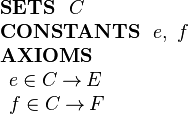Structured Types: Difference between revisions
imported>WikiSysop |
imported>WikiSysop |
||
| Line 16: | Line 16: | ||
</center> | </center> | ||
We can model this structure in Event-B by introducing (in a context) a set <math>C</math> and two | |||
functions <math>e</math> and <math>f</math> as constants as follows: | |||
<center> | <center> | ||
| Line 32: | Line 34: | ||
</center> | </center> | ||
'''Names in the proof tree:''' Predicate Prover | '''Names in the proof tree:''' Predicate Prover | ||
Revision as of 15:57, 1 May 2009
Structured Types as Projections
The Event-B mathematical language currently does not support a syntax for the direct definition of structured types such as records or class structures. Nevertheless it is possible to model structured types using projection functions to represent the fields/ attributes. For example, suppose we wish to model a structured type C with fields e and f (with type E and F respectively). Let us use the following syntax for this (not part of Event-B):

|
We can model this structure in Event-B by introducing (in a context) a set  and two
functions
and two
functions  and
and  as constants as follows:
as constants as follows:

|
Names in the proof tree: Predicate Prover
Names in the preferences: PP restricted, PP after lasso, PP unrestricted
Input: In the configuration "restricted" all selected hypotheses and the goal are passed to New PP. In the configuration "after lasso" a lasso operation is applied to the selected hypotheses and the goal and the result is passed to New PP. The lasso operation selects any unselected hypothesis that has a common symbol with the goal or a hypothesis that was selected before. In the configuration "unrestricted" all the available hypotheses are passed to New PP.
How the Prover Proceeds: First, all function and predicate symbols that are different from " " and not related to arithmetic are translated away. For example
" and not related to arithmetic are translated away. For example  is translated to
is translated to  . Then New PP translates the proof obligation to CNF (conjunctive normal form) and applies a combination of unit resolution and the Davis Putnam algorithm.
. Then New PP translates the proof obligation to CNF (conjunctive normal form) and applies a combination of unit resolution and the Davis Putnam algorithm.
Some Strengths:
- New PP outputs a set of "used hypotheses". If an unused hypotheses changes, the old proof can be reused.
- New PP has limited support for equational reasoning.